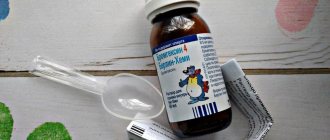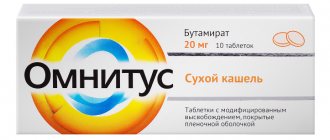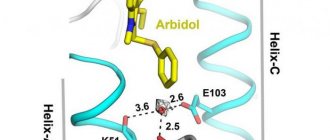Pharmacodynamics and pharmacokinetics
Bromhexine 8 Berlin-Chemie is characterized by secretolytic (mucolytic) and secretomotor (expectorant) effectiveness, and also has a weak antitussive effect. Taking the drug reduces the viscosity of bronchial secretions , stimulates ciliated epithelial , increases the amount of sputum and promotes its rapid discharge. In addition, the drug activates the production of endogenous surfactant the alveolar epithelium during respiration . The maximum effectiveness of therapy is observed on days 2-5 from the start of taking the drug.
When taken orally (inside) for 30 minutes, almost complete absorption of bromhexine (99%) in the gastrointestinal tract is observed. The bioavailability of the drug is at the level of 80%. Bromhexine is 99% bound to plasma proteins It has the ability to penetrate the blood-brain and placental barriers, as well as into the milk of a nursing mother. Hepatic metabolic transformations occur through oxidation and demethylation , up to the formation of ambroxol . The average T1/2 due to slow reverse tissue diffusion is 15 hours. Excretion is carried out by the kidneys (urine) in the form of metabolites . Repeated use leads to the accumulation of the drug in the human body. With chronic renal failure of metabolic products is impaired.
Composition and dosage form of the drug
The drug "Bromhexine Berlin-Chemie" is produced in the form of dragees containing the active ingredient bromhexine hydrochloride. Dragees (tablets) are packaged in blister packs of 25 pieces, which are packed in a cardboard box with instructions for the pharmacological drug. In addition to the active ingredient, the medication contains additional substances such as lactose monohydrate, corn starch, sucrose, magnesium stearate, glucose syrup, macrogol 6000, talc, titanium dioxide and some other auxiliary elements.
Indications for use
The use of Bromhexine Berlin-Chemie is indicated in the case of bronchopulmonary diseases of a chronic or acute course, accompanied by the production of viscous sputum:
- pneumoconiosis;
- bronchial asthma;
- cystic fibrosis;
- pneumonia;
- emphysema ;
- tracheobronchitis;
- bronchiectasis;
- obstructive bronchitis;
- tuberculosis.
What is Bromhexine Berlin-Chemie
For bacterial diseases of the bronchi, it is important to facilitate the process of coughing. If the sputum stagnates, the inflammation will begin to progress and may develop into bronchopneumonia. Bromhexine Berlin-Chemie is a group of drugs developed in Germany for the treatment of acute and chronic bronchial diseases caused by exposure to viruses and bacteria. The medicine reduces the viscosity of sputum, which makes it easier to discharge.
Compound
The main active ingredient of the medicine is bromhexinum hydrochloride. Adhatoda Vasika is the source for obtaining it. Vasicin, which is part of the plant, thins mucus, stimulates sputum production and normalizes body temperature. After research, pharmacists were able to synthesize a complete chemical analogue of this plant substance - bromhexinum. The table below shows the complete composition of one tablet of the drug and 100 ml of syrup.
| Release form | Components | Concentration in grams |
| Syrup | Bromhexinum hydrochloride | 0,08 |
| Propylene glycol | 25 | |
| Sorbitol | 40 | |
| Apricot scented concentrate | 0,05 | |
| Hydrochloric acid solution (3.5%) | 0,156 | |
| Purified water | 49,062 | |
| Pills | Bromhexinum hydrochloride | 0,008 |
| Lactose monohydrate | 0,0344 | |
| Corn starch | 0,0146 | |
| Gelatin | 0,0018 | |
| Colloidal silicon dioxide | 0,0006 | |
| Magnesium stearate | 0,0006 | |
| Sucrose | 0,0027 | |
| Calcium carbonate | 0,0004 | |
| Magnesium carbonate | 0,001507 | |
| Talc | 0,001750 | |
| Macrogol 6000 | 0,001750 | |
| Glucose syrup | 0,001639 | |
| Titanium dioxide | 0,00166 | |
| Povidone K25 | 0,0002 | |
| Carnauba wax | 0,00012 | |
| Quinoline yellow dye | 0,000146 |
pharmachologic effect
The drug has a secretolytic effect. It reduces the viscosity of mucus, increases the volume of sputum, activates the production of endogenous surfactant and the activity of ciliated epithelial cells. With repeated use, the drug can accumulate in the body. When taken orally, 99% of the drug is absorbed by the gastrointestinal tract (GIT) within 30 minutes. The effect of the drug appears 2-3 days after the start of treatment.
Release forms
Bromhexine 4 is produced in the form of tablets. Berlin-Chemie tablets are small in size and packaged in blister packs. The pack contains 1 blister with 25 tablets. Bromhexine 8 is available in syrup form. Thanks to the light peach flavor, this form of medicine is more popular with children. A measuring spoon is packaged with the bottle. Berlin-Chemie syrup should be used within 3 months of first opening. Tablets should not be used after the expiration date.
Indications for use Bromhexine Berlin-Chemie
Both forms of the drug are prescribed orally for the treatment of bronchopulmonary chronic diseases. Thanks to its expectorant mucolytic effect, the drug helps with acute bronchitis and tracheobronchitis. The syrup can be used in the treatment of bronchial asthma, pneumonia, emphysema, tuberculosis, cystic fibrosis, pneumoconiosis and bronchiectasis, obstructive bronchitis.
Contraindications
Taking bromhexine is absolutely contraindicated if:
- breastfeeding;
- personal hypersensitivity to bromhexine and/or other components of the drug;
- sugar intolerance;
- pregnancy in the first trimester;
- exacerbation of peptic ulcer ;
- under the age of 6 years.
Relative contraindications are:
- / liver pathologies ;
- tendency to gastrointestinal bleeding ;
- disturbances of bronchial motility with excessive concentration of secretions.
Contraindications Bromhexine Berlin-Chemie
In case of hypersensitivity to the components of the drug, the medicine is not prescribed. The antitussive is used with caution in cases of tendency to gastric bleeding, impaired bronchial motility with excessive accumulation of secretions, liver or kidney failure, and for the treatment of patients under 6 years of age. Absolute contraindications are:
- 1st trimester of pregnancy;
- peptic ulcer of the duodenum and stomach;
- intolerance to all forms of sugar, including fructose and galactose;
- lactase deficiency.
Side effects
As a rule, treatment with bromhexine is tolerated without any negative effects.
In some rare cases, the following were observed: nausea / vomiting , dyspeptic , dizziness , exacerbations of peptic ulcers , shortness , headaches , chills, fever, as well as allergic manifestations (skin rash , swelling , rhinitis ).
anaphylactic shock may occur .
Sometimes an increase in the activity of liver transaminases .
If any allergic , you must stop taking bromhexine and inform your doctor about the observed symptoms.
Side effects
During treatment with a drug, some negative side effects may occur, which include:
- Allergic manifestations of varying severity: skin itching accompanied by rashes (in most cases in the form of urticaria), fever, respiratory dysfunction, sudden onset of bronchospasm, angioedema.
- In some cases, the drug can provoke attacks of nausea and unexpressed pain in the abdomen, diarrhea, and various dyspeptic symptoms. In laboratory blood tests, an increase in aminotransferase activity is possible. In rare cases, signs of Stevens-Johnson and Lyell syndrome may appear.
Instructions for use Bromhexine 8 Berlin-Chemie
The instructions for Bromhexine Berlin-Chemie include oral (oral) administration of tablets (dragées). The tablets should be taken whole immediately after meals and washed down with 200-250 ml of water.
A single dosage of B romhexine for patients over 14 years of age is 1-2 tablets (dragées) taken three times per 24 hours.
For body weights up to 50 kilograms, as well as at the age of 6-14 years, a single dose is equal to 1 tablet (dragée) 8 mg, with a similar frequency of doses per day.
In case of existing / liver pathologies, it may be necessary to reduce the recommended dosage or reduce the number of doses, which requires consultation with a doctor.
The duration of prescribed therapy is determined by the attending physician and depends on the diagnosed disease and the severity of its course. If treatment is necessary for more than 4-5 days, you should consult a doctor.
For the treatment of children from 2 to 6 years old, the Berlin-Chemie company produces bromhexine syrup with a dosage of 4 mg/5 ml, which is taken three times a day, 5 ml.
Bromhexine analogs
Russian manufacturers produce drugs of similar composition. The creation of tablets and syrups containing bromhexine is carried out by Pharmstandard, OZONE, Akrkhin. The average price of Bromhexine from these manufacturers is 40 rubles. The closest foreign analogue of Bromhexine Berlin-Chemie is Bronchotil. 100 ml of syrup contains 4 mg of active ingredient. Ambroxol is a metabolite of Bromhexine. This drug should not be given to children under 12 years of age. In pharmacies in St. Petersburg and Moscow you can find the following analogues of Bromhexine Berlin-Chemie:
- Phlegamine;
- Solvin;
- Bronchostop;
- Flexoxin.
Overdose
No life-threatening adverse effects were observed when taking excessive doses of bromhexine Possible symptoms of overdose were limited to nausea / vomiting , diarrhea and other dyspeptic symptoms.
The recommended treatment is to induce vomiting and cleanse the gastrointestinal tract (if an overdose is detected in the first 60-120 minutes). Subsequent therapy should be appropriate to the observed symptoms.
Reviews
Medicines based on the active element bromhexine have been produced by domestic and foreign pharmaceutical companies for several decades and are still very popular. There are many favorable reviews about the drug Bromhexine 8 Berlin-Chemie, in which patients indicated its effectiveness, safety and easy tolerability. With the development of pathologies accompanied by a cough with viscous sputum, the drug significantly accelerates the recovery period, normalizes the respiratory functions and well-being of the patient.
We reviewed the instructions for use for Bromhexine Berlin-Chemie tablets.
Interaction
The drug is not compatible with alkaline solutions .
Due to the difficulty of removing liquefied sputum , the combined use of the drug with drugs that have a depressing effect on the cough center (including codeine-containing drugs ) should be avoided.
In the first 4-5 days of antibiotic therapy using Amoxicillin , Erythromycin , Oxytetracycline , Cephalexin and Ampicillin and simultaneous administration of Bromhexine bronchial secretions may increase .
Special Recommendations
When prescribing Bromhexine 8 Berlin Chemie to patients with a history of bleeding or peptic ulcers of the gastrointestinal tract, increased caution is required. The development of any changes in the skin requires discontinuation of drug therapy. Also, increased attention is paid to patients with bronchial motility disorders, in which a large amount of thick sputum is produced. Reducing the dosage of the medication or lengthening the intervals between doses is necessary for people with kidney pathologies or impaired liver function. If a long therapeutic course is necessary, then periodic laboratory monitoring of biochemical blood parameters is important. The described pharmacological agent is contraindicated for malabsorption syndrome and fructose intolerance.
In women during pregnancy and lactation, the medication is taken after assessing the risk-benefit ratio. Taking pills is allowed from the age of 6 years. The product does not affect the speed of reaction when operating machinery and vehicles. The instructions for use for Bromhexine 8 Berlin-Chemie confirm this.
special instructions
During therapy, you need to consume an increased amount of fluid, which helps to increase the secretolytic effectiveness of Bromhexine .
If bronchial motility or if there is a large volume of sputum , caution should be exercised, as these conditions contribute to the retention of secretions .
In case of severe kidney pathologies, Bromhexine .
In order to facilitate the removal of bronchial secretions , it is recommended in childhood to combine Bromhexine with vibration massage of the chest or postural drainage .
Contraindications to the use of the drug
"Bromhexine 8 Berlin-Chemie" is prohibited for use in patients with the following natural or pathological conditions:
- the presence of hypersensitivity reactions to the main active element or to an additional substance;
- pregnancy, lactation.
There are also some restrictions that are included in the list of relative contraindications to the medication. These include:
- pathologies of the respiratory system, in which there is excessive accumulation of pathological bronchial secretions;
- kidney or liver diseases;
- peptic ulcers in the digestive organs.
Analogs
Level 4 ATX code matches:
Mukolik
Abrol
Ambrosan
Bronchorus
ACC 100
ACC 200
ACC Long
ACC
Mukolwan
Lazolvan
Bromhexine 8
Bromhexine
Bronchobos
Carbocisteine
Erdomed
Pulmozyme
Pectolvan C
Halixol
Ambrobene
Acetylcysteine
- Ambrobene;
- ACC;
- Acestine;
- Libexin;
- Ambroxol;
- Bronchoxol;
- Ascoril;
- Lazolvan;
- Sinupret;
- Fluditek;
- Flavamed;
- Fluimucil;
- Halixol , etc.










